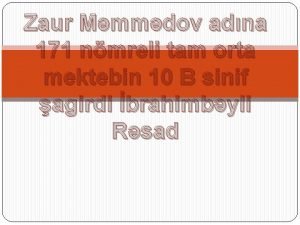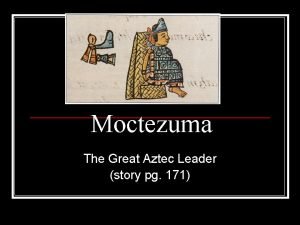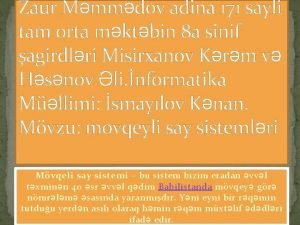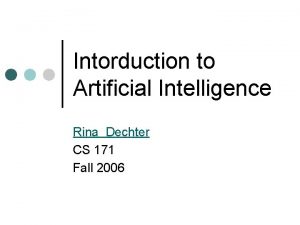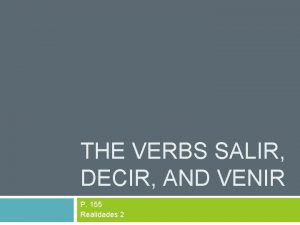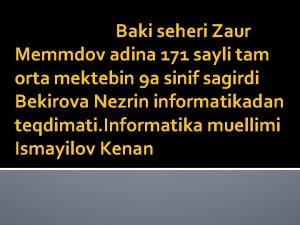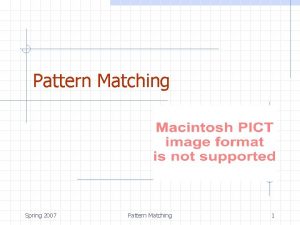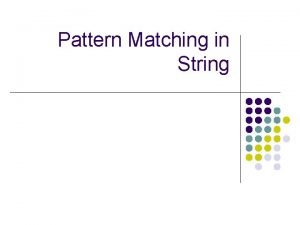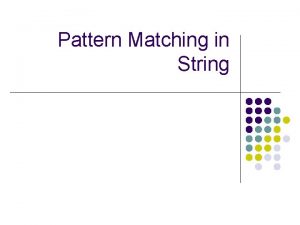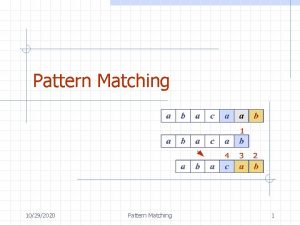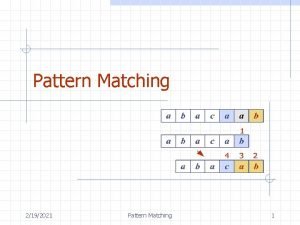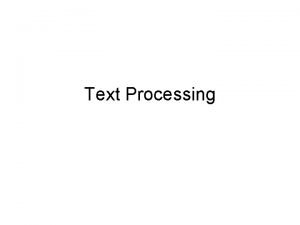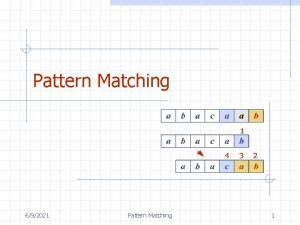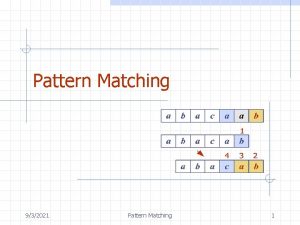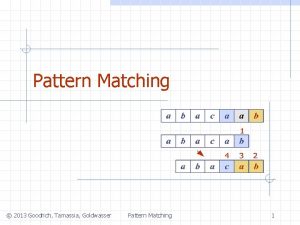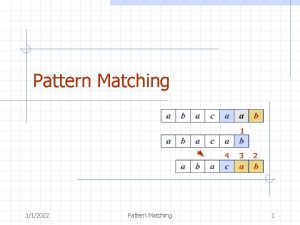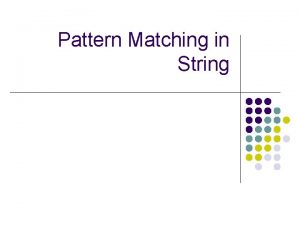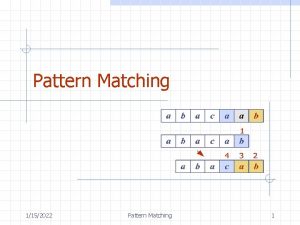COMP 171 Spring 2009 Pattern Matching Pattern Matching













- Slides: 13

COMP 171 Spring 2009 Pattern Matching

Pattern Matching / Slide 2 Pattern Matching * Given a text string T[0. . n-1] and a pattern P[0. . m-1], find all occurrences of the pattern within the text. * Example: T = 00001010001 and P = 0001: first occurrence starts at T[1]. n second occurrence starts at T[5]. n third occurrence starts at T[11]. n

Pattern Matching / Slide 3 Naïve algorithm Worst-case running time = O(nm).

Pattern Matching / Slide 4 Can we do it better? * The naïve algo is O(mn) in the worst case * But we do have linear algorithm (optional): Boyer-Moore n Knuth-Morris-Pratt n Finite automata n * Using idea of ‘hashing’! Robin-Karp algorithm

Pattern Matching / Slide 5 Boyer-Moore Algorithm * Basic idea is simple. * We match the pattern P against substrings in the text string T from right to left. * We align the pattern with the beginning of the text string. Compare the characters starting from the rightmost character of the pattern. If fail, shift the pattern to the right, by how far?

Pattern Matching / Slide 6 Rabin-Karp Algorithm * Key idea: Think of the pattern P[0. . m-1] as a key, transform it into an equivalent integer p. n Similarly, we transform substrings in the text string T[] into integers. n 1 For s=0, 1, …, n-m, transform T[s. . s+m-1] to an equivalent integer ts. n * If The pattern occurs at position s if and only if p=ts. we compute p and ts quickly, then the pattern matching problem is reduced to comparing p with n-m+1 integers.

Pattern Matching / Slide 7 Rabin-Karp Algorithm * How to compute p? p = 2 m-1 P[0] + 2 m-2 P[1] + … + 2 P[m-2] + P[m-1] * Using Horner’s rule This takes O(m) time, assuming each arithmetic operation can be done in O(1) time.

Pattern Matching / Slide 8 Rabin-Karp Algorithm * Similarly, to compute the (n-m+1) integers ts from the text string. This takes O((n – m + 1) m) time, assuming that each arithmetic operation can be done in O(1) time. * This is a bit time-consuming. *

Pattern Matching / Slide 9 Rabin-Karp Algorithm * A better method to compute the integers incrementally using previous result: compute offset = 2 m Horner’s rule to compute t 0 t. S-1 t. S This takes O(n+m) time, assuming that each arithmetic operation can be done in O(1) time.

Pattern Matching / Slide 10 Problem * The problem with the previous strategy is that when m is large, it is unreasonable to assume that each arithmetic operation can be done in O(1) time. n * In fact, given a very long integer, we may not even be able to use the default integer type to represent it. Therefore, we will use modulo arithmetic. Let q be a prime number so that 2 q can be stored in one computer word. n This makes sure that all computations can be done usingle-precision arithmetic.

Pattern Matching / Slide 11 O(m) O(n+m) Compute equivalent integer for pattern

Pattern Matching / Slide 12 * Once we use the modulo arithmetic, when p=ts for some s, we can no longer be sure that P[0. . m-1] is equal to T[s. . s+ m -1 ]. * Therefore, after the equality test p = ts, we should compare P[0. . m-1] with T[s. . s+m-1] character by character to ensure that we really have a match. * So the worst-case running time becomes O(nm), but it avoids a lot of unnecessary string matchings in practice.

Pattern Matching / Slide 13 A spell checker with hashing Start by reading in words from a dictionary file named dictionary. The words in this dictionary file will be listed one per line, sorted alphabetically. Store each word in a hash table, using chaining to resolve collisions. Start with a table size of roughly 4 K entries (the table size should be prime). If necessary, rehash to a larger table size to keep the load factor less than 1. 0. After hashing each word in the dictionary file, read in the user-specified text file and check it for spelling errors by looking up each word in the hash table. A word is defined as a string of letters (possibly containing single quotes), separated by white space and/or punctuation marks. If a word cannot be found in the hash table, it represents a possible misspelling.



